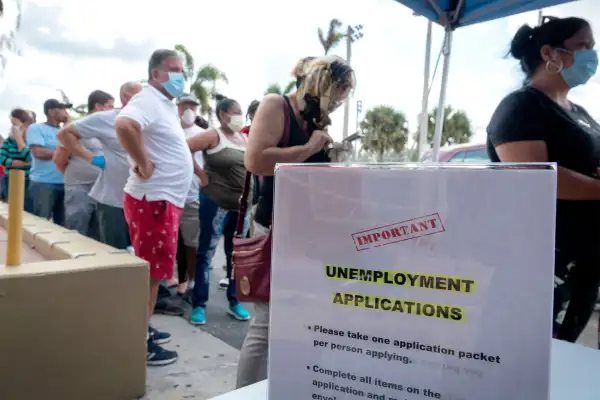5 Numbers That Show the Unemployment Crisis Is Probably Even Worse Than You Think

Jobs data from the Bureau of Labor Statistics seem to show a nation in recovery: In August, the U.S. unemployment rate fell for the fourth consecutive month, according to the agency, and the number of unemployed workers dropped by 2.8 million.
But those “official” government figures — which the Labor Department is expected to update soon — paint only a partial picture of how Americans are struggling across wide swaths of the country as the coronavirus pandemic grinds into its eighth month.
About one-fifth of U.S. renters face eviction through the end of 2020, according to the Aspen Institute, and millions more are late on their mortgage payments. The end of the $600 weekly CARES Act boost to out-of-work Americans, and the $300 FEMA-funded payments that some states followed it with, have left some of the neediest people with the least amount of aid — especially in states that offer dismally low weekly benefit maximums, like Missouri ($235) and Louisiana ($235). Black and Latino Americans are, unsurprisingly, bearing the brunt of the burden.
No single data point can sum up the complex unemployment situation in the U.S. right now (especially when those statistics are susceptible to overlap and other counting errors). But there's more to consider than just the national unemployment rate.
Here are five other numbers that can help you fill in the blanks.
Unemployment Numbers, and Why Extended Benefits Are So Important
61.7%
The civilian labor force participation rate, which measures the share of the population that’s either currently working or looking for work, hit 61.7% in August, according to the Bureau of Labor Statistics.
That was up from April’s low of 60.2%, but it’s still nowhere near normal. Even during the Great Recession, the lowest the participation rate got was 65.6%. Demographics partly contribute to the overall decline, but it may also indicate that Americans feel so discouraged by the state of things they’re not even trying to find work. (The official unemployment number only counts those Americans who are actively looking for work — it doesn't reflect those who have given up and dropped out of the labor force.) The lower the labor participation rate, the fewer resources the U.S. has to produce goods and services.
7 million
As of August, the BLS said there were nearly 7 million people who were not in the labor force but who wanted a job.
This number is down from April, during which roughly 10 million people weren’t working but wanted to. But it represents a significant increase from a year ago, when about 5 million Americans were in that situation. For context, even during the Great Recession, this figure never exceeded 6 million.
13.2%
The national unemployment rate dropped to 8.4%, in August, according to BLS data. But that's only part of the story: Local economies are struggling.
Ten states had jobless rates that exceeded that 8.4% figure in August. Nevada, Rhode Island, New York and Hawaii have the highest jobless rates in the country. As of August, Nevada had the highest rate — a whopping 13.2%.
1 in 5
Roughly one in five U.S. adults say they’ve seen their hours slashed or pay cut due to the coronavirus crisis, according to a recent survey from the Pew Research Center. Of those, some 60% are earning less than they were prior to the pandemic.
So states may be reopening, but not everyone is bouncing back. The Pew survey also found that half of people who lost their jobs are still out of work. Americans are still having trouble making ends meet, leading them to borrow money or tap into their savings to cover basic necessities.
27
According to the Economic Policy Institute, there have now been 27 consecutive weeks where the total number of people filing for unemployment was higher than the worst part of the Great Recession.
That number is important because most states give people 26 weeks, or six months, of support. Though there are a handful of pandemic-specific programs in place to help Americans who lost their jobs right as the outbreak began stateside, unemployment benefits are running out.

